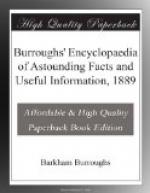GEOMETRICAL LATHE.
The fine line is the characteristic of the various and beautiful figures which are seen on a genuine note. This line is produced by what is called the Geometrical Lathe. The patterns made by the geometrical lathe are of every variety of form. They are not engraved directly upon the bank-note plate, but on pieces of soft steel plate, which are afterwards hardened. The impressions are then transferred to a soft steel roller, which, in its turn, is also hardened, and the impressions remain there, in relief. This roller is then capable of transferring the same designs to the bank-note plate by means of the transfer press.
In counterfeit engraving, the design is made directly upon the plate, and not by transfer, as in the production of plates for genuine notes. The essential difference between the two methods of production is, the counterfeit is made by hand, and is inexact and imperfect, while the genuine is made on geometrical principles, and is therefore exact, artistic and beautiful.
In all the government issues the geometric lathe work is liberally used. This should be studied carefully, as it constitutes the chief test of genuineness.
Fine lines, of unerring exactness, never broken, are seen on the genuine medallion heads, or shields, upon which the designation of the note is sometimes stamped. This nicety cannot be given by hand, or with the use of imperfect machinery. By close scrutiny the lines will be found to break off in the pattern, or appear forked, irregular in size, and not well defined throughout.
[Illustration]
On most counterfeits the vignettes are not well engraved, and the portraits have a dull appearance; the letters are usually wanting in clearness; the printing is sometimes faulty, by which some features of the note are obscured.
RULING ENGINE WORK.
In Ruling Engine Work, as it is called, the fine line is present, also. The engraving is produced and transferred in the same way as the geometrical lathe work. In this they are parallel and not in circles. Those which constitute the shading of letters are so fine that they form a perfectly even gray shade. They may be printed so that the shading will appear darker, but the aspect will be uniform. The spaces between lines are exact, whether the lines be horizontal or diagonal. The lines are also made crooked or wave-like, not absolutely parallel. Ruling engine work is generally used for shading of names of banks, and also for the names of town, state, etc.
VIGNETTES.
While lathe work and that of the ruling engine are invariably machine work, and therefore cannot be successfully reproduced by counterfeiters, the Vignettes are chiefly the work of the hands. In all genuine work they are made by first class artists, who are well paid for their services, and who therefore have no incentive to exercise their skill for illegitimate purposes.




